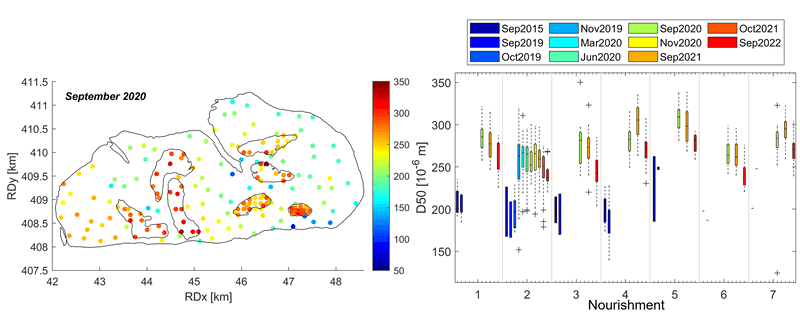N.P. Vermeer1*, P.L.M. de Vet1, A.T.M. de Bakker1, J.J. van der Werf1,2, V. Escaravage3, S. van Donk3, J. van Belzen3,4, T.J. Bouma4, H. de Looff5, K. Buis5
1Deltares; 2University of Twente; 3Wageningen Marine Research; 4NIOZ; 5Rijkswaterstaat
*corresponding author: nienke.vermeer@deltares.nl
Introduction
The construction of the Eastern Scheldt storm surge barrier (1986) resulted in intertidal flat erosion. This has negative effects on the natural as well as other values of the Eastern Scheldt. After all, the intertidal areas serve as a resting and foraging area for birds, marine mammals, and fish.
In the autumn of 2019, a large-scale nourishment (1.13 Mm3) was accomplished on the Roggenplaat (Eastern Scheldt), to compensate for the loss of bird foraging area. This Roggenplaat nourishment consist of seven elements, with each element being unique in terms of their location, elevation, and thickness of the sediment layer. Rijkswaterstaat, together with WMR, Deltares, NIOZ, Deltamilieu Projecten, and the HZ, has set up an extensive long-term eco-morphological monitoring campaign on the Roggenplaat since 2015 to evaluate the impact of this nourishment and to gather understanding on the mechanisms involved.
Objective and Methods
The sediment characteristics (e.g. grain size) are of key importance to the ecological development and functioning of the nourishment as it is one of the key factors determining recolonisation of benthic macrofauna. For example, too coarse sediment (especially in the absence of fines) implies lower moisture content which likely undermines recolonisation. The median grain size of the nourishment can be controlled to some extent, but there is little insight into how the grain size develops after nourishing.
Using an extensive dataset of grain sizes and silt content of the sediment of the Roggenplaat and the nourishments from 2015 (five years prior to nourishing) until 2022 (three years after nourishing), the evolution of these sediment parameters was studied. The number of sample points differed per sampling period, ranging from 30 in October 2019 to 208 in September 2022.
Results
The sediment samples provide insight into the development in grain size and silt content of the nourishments and surrounding areas. The median grain size of the nourishments was substantially larger (250/350 μm) than the surrounding areas (175/225 μm) (see Figure). The median grain size has been decreasing in recent years on all nourishments. Moreover, the silt content on the nourishments has been increasing, while immediately after nourishing there was no silt present on the nourishments. Research is still ongoing to identify which processes control these changes in grain size and silt content.

(left) Overview of the sampled median grain sizes for September 2020 (directly after nourishing) on the Roggenplaat. The contours and numbering of the nourishments and the low tide line are displayed. (right) The median grain size (D50) per sampling period per nourishment.
References
Van der Werf, J., M. Boersema, A. Nolte, R. Schrijvershof, J. Stronkhorst, L. De Vet, B. Walles, T. Ysebaert (2016b). Definitief ontwerp Roggenplaat suppletie. Centre of Expertise Delta Technology, Deltares rapport 1220324-000-ZKS-009.


